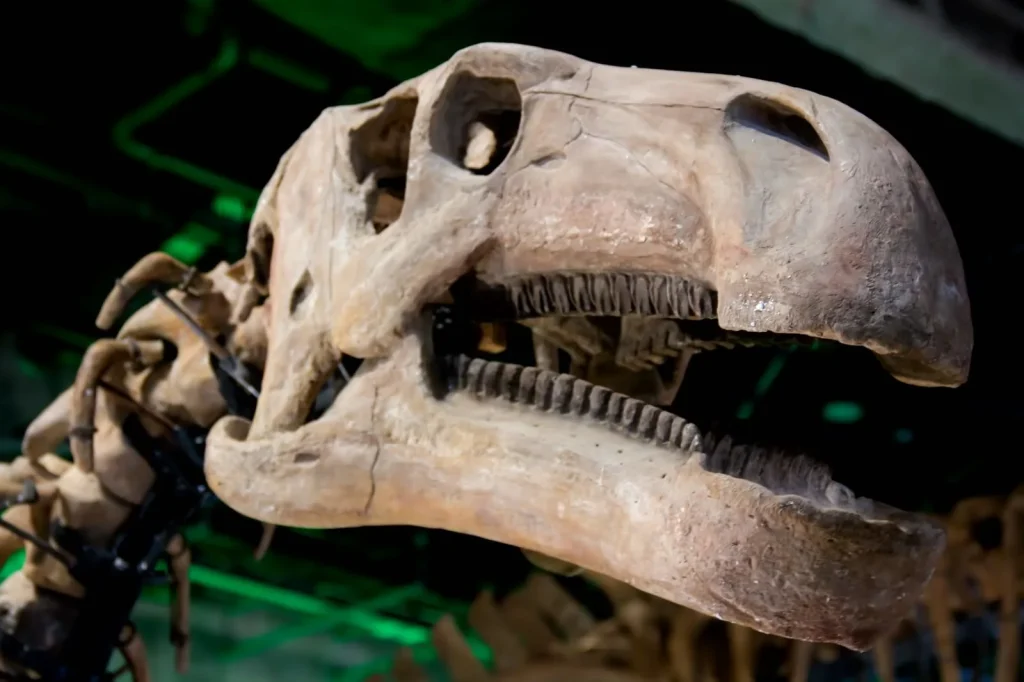Japan, known for its rich cultural heritage and stunning landscapes, holds a hidden treasure beneath its soil—dinosaur fossils that unlock the mysteries of Earth’s ancient past.
In this blog post, we embark on a journey through time to explore the fascinating discoveries of dinosaur fossils in Japan, shedding light on the prehistoric creatures that once roamed the archipelago.
Dinosaur Fossils in Japan

1. The Dinosaur Realm in Japan: A Geological Overview
Japan’s geological history unveils a diverse landscape that was once home to a variety of dinosaurs. The archipelago’s different regions have yielded fossilized remains, providing scientists with invaluable insights into the dinosaur diversity that thrived millions of years ago.
2. Hokkaido’s Cretaceous Chronicles: The Dinosaur Highway
Hokkaido, Japan’s northernmost island, boasts a remarkable track record of dinosaur discoveries from the Cretaceous period. Dinosaur fossils found in this region include herbivores like the Fukuititan and theropods like the Fukuiraptor, contributing to our understanding of the ecosystem during this era.
3. The Majestic Fukui Prefecture: A Dinosaur Fossil Hotspot
Fukui Prefecture has emerged as a hotspot for dinosaur fossils in Japan. The Fukui Dinosaur Museum stands as a testament to the region’s paleontological significance, housing an extensive collection of fossils, including the iconic Fukuiraptor, discovered in the Kitadani Formation.
4. Kitadani Formation: Unraveling the Secrets of the Late Cretaceous
The Kitadani Formation, located in the heart of Fukui Prefecture, has become synonymous with dinosaur discoveries. Its sedimentary layers have preserved a wealth of fossils, offering scientists a time capsule into the Late Cretaceous period.
5. The Fukuiraptor: A Carnivorous Wonder from Fukui
One of the standout discoveries in Fukui is the Fukuiraptor. Belonging to the theropod family, this carnivorous dinosaur walked the Kitadani Formation around 90 million years ago. Its fossils have provided crucial information about the predator-prey relationships in the region.
6. The Mystery of the Hadrosaurid in Nagasaki: A Southern Surprise
Nagasaki, located in the southern part of Japan, has contributed to the dinosaur narrative with the discovery of hadrosaurid fossils. The presence of these herbivorous dinosaurs in southern Japan raises questions about the distribution and behavior of dinosaurs across the archipelago.
7. The Saga of Dinosaur Eggs: Nesting Grounds Revealed
Dinosaur eggs discovered in Japan have unveiled nesting grounds that provide insights into the reproductive behavior of these ancient creatures. The well-preserved eggs found in various regions add a layer of complexity to our understanding of dinosaur family dynamics.
8. Jurassic Treasures in Shizuoka: A Glimpse into Early Dinosaur Life
Shizuoka Prefecture offers a glimpse into the Jurassic period with its dinosaur discoveries. Fossils found in this region include early dinosaur species, shedding light on the evolutionary processes that shaped these magnificent creatures.
9. Paluxysaurus from Japan: Bridging the Pacific Dinosaur Connection
The discovery of a dinosaur footprint resembling the Paluxysaurus, typically associated with North America, suggests a potential connection between the dinosaur populations of Japan and the ancient landmasses that would later become the Americas.
10. Dinosaur Paleontology in Japan: Collaborations and Research Initiatives
Japan’s commitment to unraveling its prehistoric past is evident in the collaborative efforts of paleontologists, researchers, and institutions. Ongoing excavations and research initiatives continue to expand our knowledge of Japanese dinosaurs and their role in the global paleontological narrative.
11. Dinosaur Fossil Preservation Techniques: Safeguarding Ancient Clues
Preserving dinosaur fossils is a delicate process that involves cutting-edge techniques to safeguard these ancient clues. Japanese paleontologists employ advanced methods to ensure the integrity of fossils and extract maximum information from each discovery.
12. Dinosaur Fossils and Cultural Heritage: Museums and Education
Dinosaur fossils not only contribute to scientific knowledge but also play a crucial role in education and cultural heritage. Museums across Japan showcase these fossilized wonders, engaging the public and fostering a deeper appreciation for the country’s paleontological history.
13. Conservation Challenges: Balancing Preservation and Exploration
The delicate balance between preserving dinosaur fossil sites and conducting further exploration poses challenges for conservation efforts. Japanese authorities and researchers work collaboratively to address these challenges and ensure the sustainable study of dinosaur fossils.
14. The Future of Dinosaur Discoveries in Japan: Uncharted Territories
As technology advances and exploration techniques evolve, the future of dinosaur discoveries in Japan holds the promise of unearthing even more remarkable fossils. Ongoing projects, coupled with international collaborations, position Japan as a key player in the global field of paleontology.
Conclusion:
Japan’s dinosaur fossils unveil a mesmerizing tapestry of prehistoric life, offering a window into the world of these majestic creatures that once roamed the archipelago.
From Hokkaido to Nagasaki, each discovery contributes to our understanding of dinosaur diversity, behavior, and evolution.
As Japan continues to reveal its ancient secrets, the journey into the past remains an ongoing exploration, promising further revelations and deepening our connection with the magnificent dinosaurs that shaped Earth’s history.



コメント